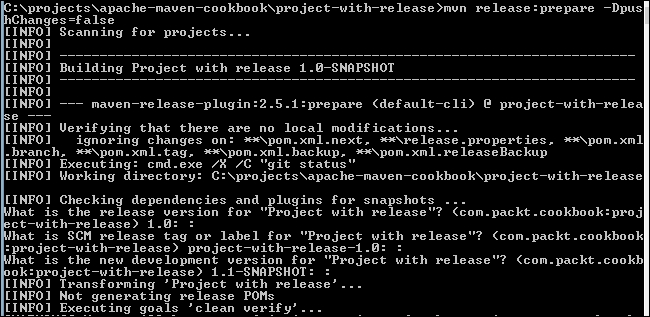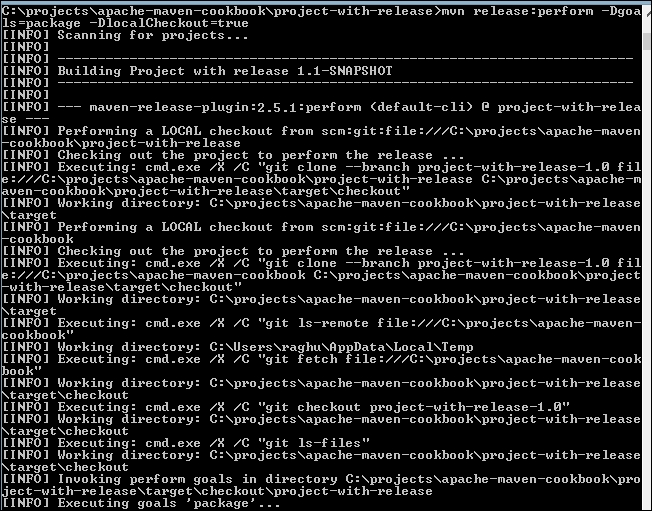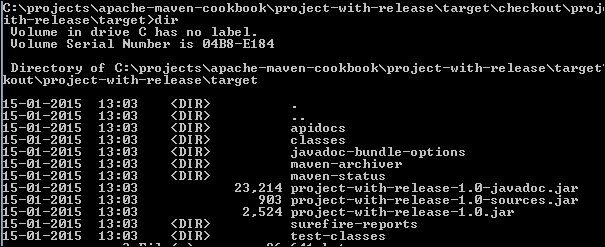The ultimate goal of any project is the release. After development is complete and bugs are fixed, it is time to release the project. Different projects are released in different ways. Web projects are released by deploying them to the web server. Other projects may be packaged into executable JARs. Still others may be packaged as executables or installers. If the project is a library or a dependency used in other projects, then it needs to be made available suitably.
As we have seen before, we use the SNAPSHOT version during development. When the project has to be released, this version now needs to be replaced with a concrete version.
One of the most advanced features of Maven is its support to do a project release. Let us explore this.
- Open a project for which you want to do a release (
project-with-release). - Verify if the SCM details are present in the pom file:
<scm> <developerConnection>scm:git:https://bitbucket.org/maruhgar/apache-maven-cookbook</developerConnection> <url>https://bitbucket.org/maruhgar/apache-maven-cookbook</url> <tag>HEAD</tag> </scm> - Add the plugin definition in order to specify the latest version of the plugin:
<plugins> <plugin> <groupId>org.apache.maven.plugins</groupId> <artifactId>maven-release-plugin</artifactId> <version>2.5.1</version> </plugin> </plugins> - Run the following Maven command:
mvn release:prepare –DpushChanges=falseBy default, changes made by the plugin are pushed to the repository. If you do not want that, set the
pushChangesconfiguration option tofalse. - Choose the default values when prompted.

You could choose the default values for the release version, the SCM tag and new development version, or provide your values.
- Observe the output:

Maven runs a number of commands that modify the pom file. Then, it checks in the changes into the repository.
- Now run the following command:
mvn release:perform –Dgoals=package –DlocalCheckout=trueBy default, the
performgoal of the Maven Release plugin runs thedeploygoal to deploy the project to the specified repository. If you do not have a remote repository to deploy to, or want to run a different goal as part of the release, you can specify it using thegoalsconfiguration. In the preceding case, we have set it to run thepackagegoal.Also, to do the release, Maven checks out the tag created by the
preparegoal from the repository. If you want Maven to check out the local copy instead, you could do so by setting thelocalCheckoutconfiguration totrue. - Observe the output:

- Ensure that the release binaries are created in the
target/checkout/project-with-release/targetfolder:
There are two steps to making a release—prepare and perform.
When the prepare goal of the Maven Release plugin is run, it does the following:
- Checks there are no uncommitted changes
- Checks that the project does not have any
SNAPSHOTdependencies - Changes the version of the
SNAPSHOTproject; you will be prompted to confirm or override the default - Adds a
tagelement to thescmelement and computes the value (by default,HEAD) - Runs the
verifygoal to ensure that the changes do not break anything - Commits the modified pom to the SCM
- Tags the code in SCM with a version name (you will be prompted to confirm or override the default):

- Bumps the version in the pom to the new
SNAPSHOTvalue (from1.0-SNAPSHOT; this would be1.1-SNAPSHOT); you will be prompted to confirm or override this - Commits the modified pom to SCM
As you can see, once the goal is met, you will have an updated SCM with a tag with the release version and the HEAD with the next SNAPSHOT version. A release.properties file is also created. It contains information that is needed for the perform goal.

The second platform does as follows:
- The perform goal uses the information in
release.propertiesto check out from the SCM tag that was created earlier - It then runs the specified goal on the checked-out project (by default,
deploy) - This generates the release binaries
Once the build is successful, release.properties and other backup files created by the Release plugin are removed.
